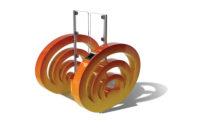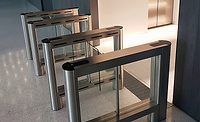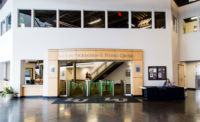Optical turnstiles are viewed as a growing trend in entrance control, currently dominating the speedgate market, according to IMS Research. As a security measure, optical turnstiles restrict or control access to a building or secured area. But they are also attractive from a design perspective as their slim footprint makes them unobtrusive. Their design attributes go hand in hand with security decisions as buildings undergoing renovations want not only the best security controls in place but want those controls to be aesthetically pleasing.
Optical turnstiles are usually a part of an access control system that consists of software, card readers and controllers. They operate much like regular mechanical turnstiles, except that they rely primarily on electronic (infrared) beams, and audible/visual interfaces to control entry. Rather than physically restraining a person, the optical turnstile uses sounds and lights to alert others to attempted entry by unauthorized individuals. The beams in opticalturnstilescan monitor the number of people entering a building by using the one card, one person system. If more than one person breaks the beam after an ID card is presented, then the system will notice. Opticalturnstilesare an extremely useful system for buildings with a high level of people entering and leaving. They are also useful for monitoring how many people are in the building at any given time in case of emergency evacuation. If someone enters without using a valid ID card, an alarm will alert security staff.
Integrating Card Readers with Optical Turnstiles
For many of the reasons discussed here, Peckham, Inc., a nonprofit organization that provides job training and competitive employment opportunities for persons with significant disabilities and other barriers to employment, chose to install optical turnstiles. Since opening its doors in 1994, Peckham has grown to be one of the largest community vocational rehabilitation programs in the state of Michigan.
But with success comes challenges, such as controlling access to the 290,000 square feet vocational building in the state’s capital of Lansing. Those who receive training often go on to find jobs and a new set of clients will follow. Additionally, clients work various shifts during the day
Peckham was already controlling entry with card readers at the main client entry where upwards of 1,000 people have authority to enter and a secured lobby whereby upon reading the card a rapid open-slide door would permit entry to the vestibule. “The problem with that was that one person would swipe their card but nine others would follow,” explains Nat Vander Laan, facilities manager at Peckham. “This made it difficult to restrict access to unscheduled visitors.” A second entrance provides guests entrance into a secured lobby.
While Peckham had not experienced any security threat from piggyback entrants, Vander Laan admits that the what-if scenario was always present. So, when the opportunity presented itself to upgrade the security system, Vander Laan wanted to research optical turnstiles and sliding gates based on what he’d heard about performance features, physical appearance and the fact that they present a barrier-free entrance for those with physical disabilities.
“More than 80 percent of the people who work here are people with a significant disability, so we didn’t want an entry path that would intercept, such as the three-arm posts on traditional turnstiles,” he says. Peckham ultimately chose a Boon Edam optical turnstile because of its retracting glass gates. This past fall, three lanes costing $30,000 each was installed, two standard lanes and one extra-wide lane to accommodate wheelchairs. A fourth turnstile is planned for an installation this year. And, as renovations plans begin in Peckham’s Charlotte, Mich. facility, conduit has been added to the floor to accommodate a future installation of optical turnstiles.
The optical turnstiles have been tied into the infrastructure of the technology. Visitors approach the gate, swipe their HID card and the gate opens. The gate stays open long enough for someone to pass – but still long enough for a piggyback to enter. “No, it’s not a 100 percent perfect barrier, but if a piggybacker does get through, an internal alarm sounds to notify the security staff immediately, and it is definitely an embarrassing-sounding alarm,” he adds. As a result, the problem of piggybackers has dropped by about 80 percent.
An Opportunity to Think Security
Problems are common when buildings undergo renovations, but taking care of incorporate security as part of a redesign can help alleviate some of the challenges. A mid-Atlantic high-rise faced critical financial issues when the departure of its primary tenant left it three-quarters vacant in the recession year of 2009. The building owners seized the opportunity to make the building more attractive by investing tens of millions in modernizing the property, which included a lobby renovation and security upgrades. As part of the security plan, the customer installed 12 lanes of optical turnstiles to control access to the two elevator bays.
Aesthetics were of prime importance to the building, which led to the purchase of the turnstiles for modern lobby security. The small footprint of the turnstiles enabled the customer to install three lanes at each entrance, providing one more lane to speed access to the elevators.
Enticing corporate tenants does require an investment in high-quality design. For example, 321 Exhibition Street in Melbourne, Australia, recently underwent a $32 million refurbishment to transform the location into a multi-tenant office building as a means of bringing in high-rent tenant companies. As part of the design, an integrated access control system and turnstile solution was required to limit access to authorized occupants and visitors. This was desired to help speed up pedestrian movement in to and up through the building.
An access control system was integrated with speedgates to allow staff to scan ID cards at the turnstile, which then direct them to the next available elevator going to their specific floor. This process is completed while verifying they have authority to access the building at that specific time.
The speed gate uses bi-directional glass barriers that remain closed until a valid card has been presented to allow the authorized user to pass. The access control barriers close quickly behind the authorized person to deter tailgaters, however infrared sensors monitor the lane to detect unauthorized entry.
A spokesperson for 321 Exhibition Street says that the integration of the turnstiles was key to ensuring a high-speed, easy-to-use and secure access and elevator destination control solution to get people in and through the building as fast as possible.
Optical turnstiles have proven themselves in building lobbies as a way to separate and clear employees carrying access control cards from visitors who must present identification and verification of their purpose in entering the building. Their elegant look and design creates an environment that is welcoming and barrier-free but still protective.
|
A Crash Course on College Vehicular Perimeter Security Systems |
|
Keeping pedestrians safe, protecting structures from accidental or intentional automobile crashes, and force protection (keeping employees and visitors from harm) have always been campus safety concerns. A variety of campuses find peace of mind through the use of barriers, barricades and bollards for vehicle-based physical access control at their perimeters.
Permanent Barriers and Barricades Bollards are the most used permanent solution on campuses. Fixed post bollards protect the perimeter of buildings at Boston University Medical Center. At Stanford University, permanent pneumatically-operated bollards restrict vehicular traffic from entering the campus via maintenance roads. They are lowered to allow access to maintenance vehicles and raised immediately. Bollard systems operate individually or in groups up to 10 and are used for intermediate level security applications. Individual bollards are up to 12.75 inches in diameter, up to 35 inches high and are usually mounted on 3-5 foot centers. They are tested to stop and destroy an attacking vehicle weighing 10,000 pounds moving at 65 miles per hour or a 20,000-pound vehicle moving at 46 miles per hour. With bollards you can create the look you want. Ranging from faceted, fluted, tapered, rings and ripples, colors, pillars, to shields, emblems and logos, bollards are aesthetically pleasing and versatile. You can specify ornamental steel trim attached directly to the bollard or select cast aluminum sleeves that slip right over the crash tube. Bollards can be galvanized for corrosion resistance, fitted with an internal warning light for increased visibility, and engineered to suit high-traffic volume. If damaged, simply slip off the old and slip on the new. UCLA uses decorative bollards throughout the campus to restrict vehicle access to student housing areas and other locations which require temporary removal. Some of the areas block access to dumpsters and roads that require temporary access during admission periods. Decorative bollards also protect the George H.W. Bush Presidential Library and Museum, located on a 90-acre site on the West Campus of Texas A&M University. The bollards are designed to protect facilities from those not authorized to enter or others driving errant vehicles.
Temporary Barriers Are Especially Popular on Campuses Quite often, vehicle access is required temporarily. Parking for the football game, a grand opening for a new wing, freshman matriculation day, and open houses are temporary events needing only a temporary solution. Such equipment now exists in the form of portable, towable barriers. The barriers can be deployed quickly and effectively, even in places where it is impossible to excavate for a permanent foundation. From a purchasing standpoint, it can be easier to purchase portable barriers than permanent barriers. The latter are oftentimes placed into an organization’s real assets budget because they are permanently installed into the ground, becoming part of the property. However, purchasing portable barriers can be no different than buying a new set of wrenches for the maintenance department. Able to be deployed in 15 minutes, they can quickly protect facilities and people from vehicle attacks and accidents. The mobile crash barriers can be towed into position by a medium-sized pick-up truck or equivalent. They operate locally or remotely for guard protection. Deployment, retrieval and operation are all hydraulic. The barriers stop and disable a 15,000-pound vehicle moving at 30 mph. Once positioned, the mobile barricade is separated from its transporter and lowered into position by means of a battery-operated hydraulic power system, which is then used to raise or lower the barrier for normal or emergency tasks. Penn State University uses seven of these barriers for home football games and special events for vehicle control and protection. Like similar applications at the University of Michigan, Ohio State, and others, PSU is able to quickly deploy the barriers at strategic sites around the facility. After the event, they are quickly knocked down and towed to another location. |





